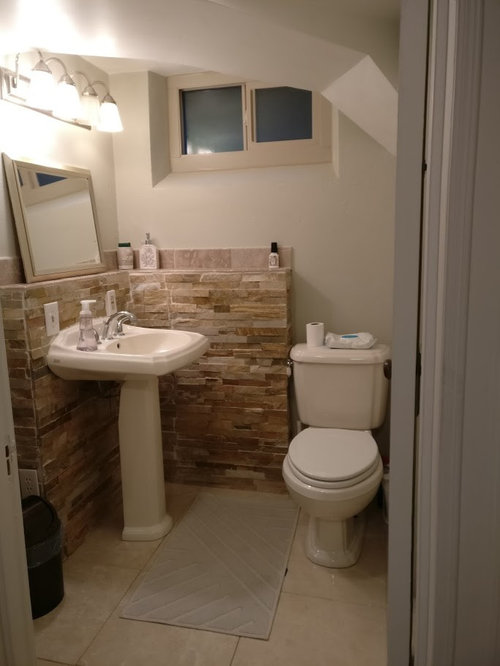Imagine this: you wake up on a Saturday morning, feeling the crisp autumn air as you sip your coffee. You’re excited for the day ahead, filled with plans for home improvement projects. But the bliss is quickly interrupted by a desperate knock on the door. It’s your neighbor, needing to use your bathroom in a hurry. Now, imagine how much more relaxed your day would be if you had an additional bathroom conveniently located on your first floor.

Image: www.greatbuildz.com
Adding a half bath to your first floor can significantly enhance the functionality and value of your home. It’s a dream come true for families who crave extra convenience, or for those who simply want to avoid the dreaded bathroom line during morning rush hour. But, cost is a major factor in this decision. This guide will take you through the cost of adding a half bath, offering expert insights and practical tips to ensure you make the most of your budget.
The Anatomy of a Half Bath Cost: Breaking Down the Basics
The cost of adding a half bath is an intricate puzzle composed of various pieces, all adding up to a final price tag. Let’s break it down into the fundamental elements:
1. Permit Fees and Inspections:
- The Foundation: These fees are the initial cost you’ll encounter. They are paid to your local building department for obtaining the necessary permits and ensuring your project meets safety codes.
- Variable Factors: Permit fees vary depending on location, the size of the project, and the specific requirements in your area.
- Average Cost: Expect to spend between $200 and $1,000 on permits and inspections.
2. Plumbing and Fixtures:
- The Lifeline of Your Half Bath: This includes the crucial plumbing work for the toilet, sink, and potentially a vent line.
- Fixture Choice Matters: The type of fixtures you choose will significantly influence the overall cost. For example, opting for a basic toilet versus a high-tech model can make a big difference.
- Average Cost: The plumbing and fixtures can range from $1,000 to $4,000, depending on your selections.
3. Labor Costs:
- The Skilled Hands: Labor costs are a significant part of the equation. This involves hiring professionals to handle the installation of the plumbing, fixtures, and any necessary electrical work.
- Regional Variations: Labor costs fluctuate depending on the region, the availability of skilled workers, and the complexity of the project.
- Average Cost: Expect to devote a substantial portion of your budget to labor, typically between $1,500 and $5,000.
4. Flooring and Walls:
- The Finishing Touches: You’ll need to consider the flooring and wall surfaces for your new half bath.
- Material Options: You have a wide range of flooring and wall materials from classic tiles to contemporary finishes.
- Average Cost: Flooring and wall finishes can add $500 to $2,000 to the overall cost.
5. Other Factors:
- Hidden Surprises: Unexpected costs can pop up, such as the need to reinforce the floor to support the weight of the toilet, or potential issues with existing plumbing or electrical infrastructure.
- Unexpected Upgrades: You may also find that adding extras like heated floors or a stylish vanity can swiftly escalate your budget.
- Budget Reserves: It’s crucial to allocate a contingency fund for these potential surprises.
Navigating the Cost Maze: Tips for a Smarter Budget
Now that you have a better understanding of the cost components, let’s discuss some practical strategies for stretching your budget:
- Prioritize Efficiency: Focus on maximizing the space while keeping the design simple. A compact half bath can be just as functional as a larger one.
- Shop Around for Deals: Take the time to compare prices for fixtures, materials, and labor. Don’t hesitate to negotiate for better pricing or look for special offers.
- DIY When Possible: For those with a handy disposition, do-it-yourself projects like installing simple fixtures or painting surfaces can help you save on labor costs. However, prioritize professional help for complex tasks like plumbing and electrical work.
- Explore Budget-Friendly Options: Choose budget-friendly options for fixtures, such as a classic toilet and a simple vanity. Consider using salvaged materials or shopping for discounted tiles and flooring.
- Don’t Sacrifice Quality: While saving money is important, don’t compromise on quality when it comes to essential components like plumbing and fixtures. Investing in durable and reliable materials can save you from costly repairs down the road.
Unlocking the Value: An Investment in Your Home
Adding a half bath to your first floor is more than just a bathroom upgrade; it’s an investment in your home’s value and your family’s comfort. Beyond the practical benefits, a well-designed half bath adds a touch of luxury and elegance to your home, making it a more inviting space for both you and potential buyers in the future.

Image: www.openbasement.com
Cost Of Adding Half Bath To First Floor
The Final Word: Your Dream Half Bath Awaits
As you navigate the process of adding a half bath to your first floor, remember to weigh the costs carefully against the value it will bring to your home and your lifestyle. Start with a solid plan, prioritize your needs, and with a bit of research and strategic planning, your dream half bath can become a reality, within a budget that fits your comfort level.






